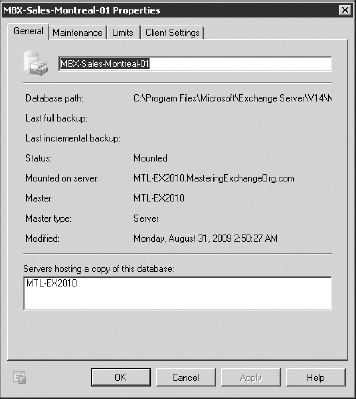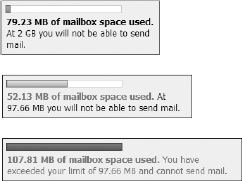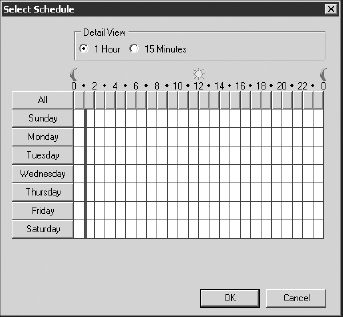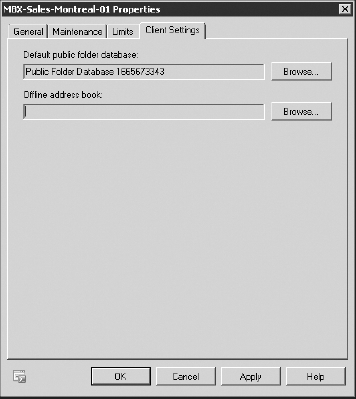5. Properties of a Mailbox Database
Now let's look at some of the properties of a mailbox database. Figure 2
shows the General tab of the mailbox database's properties dialog box.
At the top is the display name of the mailbox database. From here, you
can rename the database if you need to conform to a new database naming
standard. The path to the database is shown, but you cannot change the
path here; you must use the Move-DatabasePath cmdlet or the Move Database Path task.
There is a lot of dynamic state information on the General tab as well, including the following:
Last Full Backup
Indicates the last time a full or normal
Exchange-aware VSS backup was performed. Transaction logs would have
also been purged at that time.
Last Incremental Backup
Indicates the last time an incremental backup
was run. This backup type will back up the database's transaction logs
and then purge them.
Master
Indicates if the copy of the database is the master copy in a DAG deployment.
Master Type
Indicates the type of master copy of the database that exists on the server.
Status
Indicates if the database is mounted or dismounted.
Modified
Shows the date and time the database properties in Active Directory were last changed.

This information (including the dynamic information) can be retrieved using the -Status option of the Get-MailboxDatabase cmdlet:
Get-MailboxDatabase MTL-EX2010 -Status | FL Name,*last*,Mounted
Name : Executives
SnapshotLastFullBackup : False
SnapshotLastIncrementalBackup :
SnapshotLastDifferentialBackup :
SnapshotLastCopyBackup :
LastFullBackup : 6/22/2009 1:45:47 AM
LastIncrementalBackup :
LastDifferentialBackup :
LastCopyBackup :
Mounted : True
The next tab in the mailbox database's properties
dialog box is named Maintenance. Here we find a "potpourri" of various
configurations that relate to overall database file and content
management.
The Journal Recipient option allows you to specify a
journaling recipient for all mailboxes located on this mailbox
database. If this is enabled, a copy of any message or delivery receipt
sent or received by a mailbox on this system will be sent to the
journal mailbox.
The Maintenance Schedule drop-down list (and its
Customize button) allows you to schedule online maintenance for this
particular database. The Enable Background Database Maintenance (24 × 7
ESE Scanning) option, which is enabled by default, ensures that
database maintenance occurs at runtime. If you disable this option,
database maintenance will only run during the maintenance schedule.
The Do Not Mount This Database At Startup check box
allows you to prevent the database from being mounted after the
information store service is restarted. This might be useful when you
want to make the mailbox databases available one or two at a time
rather than all at once.
The This Database Can Be Overwritten By A Restore check box is used when you must restore a database file from a backup.
The Enable Circular Logging check box is used to
automatically purge transaction log files on the disk. In a DAG
deployment scenario, we recommend that you enable this option if you
are using mailbox database replication as a backup solution. For
organizations that use VSS-aware backup solutions, Circular Logging
should be disabled. In any case, for a stand-alone Mailbox server
scenario, Circular Logging should not be enabled, since it will allow
you to recover your mailbox database to the exact point of a total
failure when combining with an older backup. When Circular Logging is
not enabled, transaction log files will only be purged following a
successful Full or Incremental backup or when the transaction logs have
been successfully copied to another server in a DAG.
The next tab on the properties dialog box is named
Limits. The Storage Limits section allows you to specify the amount of
storage that the mailbox is allowed to have. Administrators used to
previous versions of Exchange will be surprised to learn that newly
created mailbox databases have defaults. Everyone will be surprised to see the actual default values:
Issue Warning At (KB) is set to 1,991,680
KB. When a mailbox reaches this limit, users will receive an email
message informing them that they have reached a limit on their mailbox
and they should clean up some data in it.
Prohibit
Send At (KB) is set to 2,097,152 KB. Once the mailbox hits this limit,
the user will be unable to send new messages or reply to existing
messages. Both Outlook and Outlook Web App will inform users if they
try to send a message while they are over this limit.
Prohibit
Send and Receive At (KB) is set to 2,411,520 KB. When a mailbox exceeds
this limit, the mailbox is closed or disabled. Even though the user can
access the mailbox, the server will not allow the user to send new
messages or reply to existing messages. In addition, the mailbox will
not receive any incoming mail from other Exchange users or from outside
the organization.
Outlook Web App has a neat new feature that will
inform users of how close they are to their limit or if they are over
their limit. Simply move your mouse pointer over the top of the mailbox
in the folder listing pane of Outlook Web App and you will see a pop-up
box similar to one shown in Figure 3.
The limit that you see in the messages is the Prohibit Send At (KB) limit, not the Prohibit Send And Receive At (KB) limit.
The Warning Message Interval drop-down list
determines the interval at which Exchange generates a warning message
informing users that they are over their Issue Warning limit. By
default, this is sent once daily at 1:00 a.m. local time. You can
customize this to another time, but be careful. The Select Schedule
dialog box (shown in Figure 4) has a detail view option of either 1 hour or 15 minutes.
When using any schedule box that has both a 1-hour
view and a 15-minute view, switch to the 15-minute view to set a
schedule. If you select an entire hour, whatever process you are
scheduling will run four times per hour. In this case, if you select an
entire hour, a warning message will be sent to all mailboxes over their
warning limit four times per hour. The users would not be amused.


The Deletion Settings section of the Limits tab
allows you to configure how long the server will retain deleted items
for this mailbox and how long the server will retain a mailbox once it
is deleted. The Keep Deleted Items For (Days) option specifies how many
days the Exchange server will keep items that have been deleted either
from the Deleted Items folder or via a hard delete (Shift+Delete) from
another folder. Once a message has been in the deleted item cache for
longer than this period (14 days by default for Exchange 2010), the
user will no longer be able to retrieve the message using the Recover
Deleted Items feature.
The Keep Deleted Mailboxes For (Days) option
specifies how long the mailbox database will keep a deleted mailbox
before it is permanently purged. The default is 30 days, which is
reasonable for most organizations. A mailbox that has been deleted but
not purged can be recovered using the EMC's Disconnected Mailbox
feature or via the EMS Connect-Mailbox cmdlet.
The Do Not Permanently Delete Items Until The
Database Has Been Backed Up check box tells the server that it should
not permanently purge an item or a mailbox until the mailbox database
has been backed up. This ensures that a copy of the deleted item or
deleted mailbox could be recovered from backup media if necessary.
The Client Settings tab (shown in Figure 5)
allows you to specify two configuration settings that affect the
mailboxes on this database. The first is the Default Public Folder
Database setting; this field contains the name of the public folder
database that MAPI clients should connect to first when retrieving
information about public folder hierarchy or content.

The Offline Address Book setting affects clients
that work in offline mode or local cache mode. Here you specify which
offline address book (OAB) a MAPI client should download. The default
OAB contains the default global address list and is sufficient for most
small and medium-sized businesses.
The properties you have just examined using the graphical user interface can also be examined using the Get-MailboxDatabase cmdlet. The following example retrieves mailbox database properties and sends them to a formatted list:
Get-MailboxDatabase 'Database01' | FL
JournalRecipient :
MailboxRetention : 30.00:00:00
OfflineAddressBook :
OriginalDatabase :
PublicFolderDatabase : MTL-PF-SERVER\First Storage Group\Default
ProhibitSendReceiveQuota : 2.3 GB (2,469,396,480 bytes)
Recovery : False
ProhibitSendQuota : 2 GB (2,147,483,648 bytes)
RecoverableItemsQuota : 30 GB (32,212,254,720 bytes)
RecoverableItemsWarningQuota : 20 GB (21,474,836,480 bytes)
IndexEnabled : True
IsExcludedFromProvisioning : False
IsSuspendedFromProvisioning : False
DataMoveReplicationConstraint : None
DumpsterStatistics :
DumpsterServersNotAvailable :
ReplicationType : None
AdministrativeGroup : Exchange Administrative Group (FYDIBOHF23SPDLT)
AllowFileRestore : False
BackgroundDatabaseMaintenance : True
BackupInProgress :
DatabaseCreated : True
Description :
EdbFilePath : C:\Program Files\Microsoft\Exchange
Server\V14\Mailbox\Executives\Database01.edb
ExchangeLegacyDN : /o=ExchangeOrganization/ou=Exchange
Administrative Group (FYDIBOHF23SPDLT)/cn=Configuration/cn=Servers/cn=EX2010/
cn=Microsoft Private MDB
DatabaseCopies : {Database01\EX2010}
Servers : {EX2010}
ActivationPreference : {[EX2010, 1]}
ReplayLagTimes : {[EX2010, 00:00:00]}
TruncationLagTimes : {[EX2010, 00:00:00]}
RpcClientAccessServer : Ex2010.ExchangeOrganization.com
MountedOnServer :
DeletedItemRetention : 14.00:00:00
SnapshotLastFullBackup :
SnapshotLastIncrementalBackup :
SnapshotLastDifferentialBackup :
SnapshotLastCopyBackup :
LastFullBackup :
LastIncrementalBackup :
LastDifferentialBackup :
LastCopyBackup :
DatabaseSize :
AvailableNewMailboxSpace :
MaintenanceSchedule : {Sun.1:00 AM- Sun.5:00 AM, Mon.1:00 AM-
Mon.5:00 AM, Tue.1:00 AM-Tue.5:00 AM, Wed.1:00 AM-Wed.5:00 AM,
Thu.1:00 AM-Thu.5:00AM, Fri.1:00 AM-Fri.5:00 AM, Sat.1:00 AM-Sat.5:00 AM}
MountAtStartup : True
Mounted :
Organization : ExchangeOrganization
QuotaNotificationSchedule : {Sun.1:00 AM-Sun.1:15 AM, Mon.1:00 AM-
Mon.1:15 AM, Tue.1:00 AM-Tue.1:15 AM, Wed.1:00 AM-Wed.1:15 AM, Thu.1:00 AM-
Thu.1:15 AM, Fri.1:00 AM-Fri.1:15 AM, Sat.1:00 AM-Sat.1:15 AM}
RetainDeletedItemsUntilBackup : False
Server : EX2010
MasterServerOrAvailabilityGroup : EX2010
MasterType : Server
ServerName : EX2010
IssueWarningQuota : 1.899 GB (2,039,480,320 bytes)
EventHistoryRetentionPeriod : 7.00:00:00
Name : Database01
LogFolderPath : C:\Program Files\Microsoft\Exchange
Server\V14\Mailbox\Database01
CircularLoggingEnabled : False
LogFilePrefix : E02
LogFileSize : 1024
AdminDisplayName : Database01
ExchangeVersion : 0.10 (14.0.100.0)
DistinguishedName : CN=Database01,CN=Databases,CN=Exchange
Administrative Group (FYDIBOHF23SPDLT),CN=Administrative
Groups,CN=ExchangeOrganization,CN=Microsoft
Exchange,CN=Services,CN=Configuration,DC=ExchangeOrganization,DC=com
Identity : Database01
Guid : 98119b8d-2413-4c07-b418-2d858caf34cf
ObjectCategory :
ExchangeOrganization.com/Configuration/Schema/ms-Exch-Private-MDB
ObjectClass : {top, msExchMDB, msExchPrivateMDB}
WhenChanged : 13/07/2009 1:25:05 PM
WhenCreated : 13/07/2009 1:16:02 PM
WhenChangedUTC : 13/07/2009 5:25:05 PM
WhenCreatedUTC : 13/07/2009 5:16:02 PM
OrganizationId :
OriginatingServer : DOMAINCONTROLLER.ExchangeOrganization.com
IsValid : True
Some of these properties can be changed through the EMS using the Set-MailboxDatabase cmdlet. For example, to change the Prohibit Send At (KB) quota to 100 MB, you would type this:
Set-MailboxDatabase 'Executives' -ProhibitSendQuota:100MB
Not all of the properties that you see in the output of the Get-MailboxDatabase cmdlet can be changed. Some of them are system properties. The mailbox database location must be changed using the Move-MailboxDatabase cmdlet.